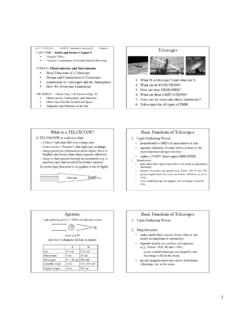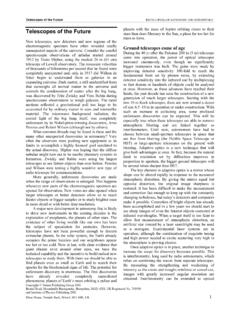Transcription of Gathering light; the telescope - University of Arizona
1 Telescopes 1 Chapter 2: Gathering light - the telescope Basic Principles Astronomy centers on the study of vanishingly faint signals, often from complex fields of sources. Job number one is therefore to collect as much light as possible, with the highest possible angular resolution. So life is simple. We want to: 1.) build the largest telescope we can afford (or can get someone else to buy for us), 2.) design it to be efficient and 3.) at the same time shield the signal from unwanted contamination, 4.) provide diffraction-limited images over as large an area in the image plane as we can cover with detectors, and 5.) adjust the final beam to match the signal optimally onto those detectors. Figure shows a basic telescope that we might use to achieve these goals.
2 Achieving condition 4.) is a very strong driver on telescope design. The etendue is constant (equation ) only for a beam passing through a perfect optical system. For such a system, the image quality is limited by the wavelength of the light and the diffraction at the limiting aperture for the telescope (normally the edge of the primary mirror). Assuming that the telescope primary is circular, the resulting image illumination is where m = ( r0 / ), r0 is the radius of the telescope aperture (=D/2 in Figure ), is the wavelength of operation, and J1 is a Bessel function of the first kind. The result is the well-known Airy function (Figure ), named after the Figure Simple Prime-Focus telescope Telescopes 2 Figure The Airy Function, British astronomer George Biddell Airy.
3 We will illustrate a simple derivation later in this chapter. The first zero of the Bessel function occurs at m= , or for small , at / D. The classic Rayleigh Criterion states that two point sources of equal brightness can be distinguished only if their separation is > /D; that is, the peak of one image is no closer than the first dark ring in the other (with high signal to noise images and computer processing, sources closer than this limit can now be distinguished reliably). The full width at half maximum (FWHM) of the central image is about /D for an unobscured aperture and becomes slightly narrower if there is a blockage in the center of the aperture ( , a secondary mirror). A common misconception is that the FWHM is /D.
4 Although we will emphasize a more mathematical approach in this chapter, recall from the previous chapter that the diffraction pattern can be understood as a manifestation of Fermat s Principle. Where the ray path lengths are so nearly equal that they interfere constructively, we get the central image. The first dark ring lies where the rays are out of phase and interfere destructively, and the remainder of the bright and dark rings represent constructive and Figure The most famous example of spherical aberration, the Hubble Space telescope before (left) and after (right) correction. Telescopes 3 destructive interference at increasing path differences. Although the diffraction limit is the ideal, practical optics have a series of shortcomings, described as aberrations.
5 There are three primary geometric aberrations: 1. spherical occurs when an off-axis input ray is directed in front of or behind the image position for an on-axis input ray, with rays at the same off-axis angle crossing the image plane symmetrically distributed around the on-axis image. Spherical aberration tends to yield a blurred halo around an image (Figure ). A spherical reflector forms a perfect image of a point source located at the center of the sphere, with the image produced on top of the source. However, for a source at infinity, the reflected rays cross the mirror axis at smaller values of f the farther off-axis they impinge on the mirror, where f is the distance along the optical axis measured from the mirror center (see Figure ).
6 The result is shown in Figure ; there is no point along the optical axis with a well-formed image. 2. coma occurs when input rays arriving at an angle from the optical axis miss toward the same side of the on-axis image no matter where they Figure Comatic image displayed to show interference. Figure The focusing properties of a spherical reflector. Telescopes 4 Figure Astigmatism enter the telescope aperture (so long as they all come from the same off-axis angle), and with a progressive increase in image diameter with increasing distance from the center of the field. Coma is axially symmetric in the sense that similar patterns are generated by input rays at the same off axis angle at all azimuthal positions.
7 Comatic images have characteristic fan or comet-shapes with the tail pointing away from the center of the image plane (Figure ). Optical systems that do not satisfy the Abbe sine condition suffer from Coma; a paraboloid is an example (see exercise ). 3. astigmatism (Figure ) is a cylindrical wavefront distortion resulting from an optical system that has different focal planes in one direction from the optical axis of the system compared with the orthogonal direction. It results in images that are elliptical on either side of best-focus, with the direction of the long axis of the ellipse changing by 90 degrees going from ahead to behind focus. Two other aberrations are less fundamental but in practical systems can degrade the images: 4.
8 Curvature of field occurs when the best images are not formed at a plane but instead on a surface that is convex or concave toward the telescope entrance aperture (see Figure ). Telescopes 5 5. distortion arises when the image scale changes over the focal plane. That is, if the system observes a set of point sources placed on a uniform grid, their relative image positions are displaced from the corresponding grid positions at the focal plane. Figure illustrates symmetric forms of distortion, but this defect can occur in a variety of other forms, such as trapezoidal. Neither of these latter two aberrations actually degrade the intrinsic images. The effects of field curvature can be removed by suitable design of the following optics, or by curving the detector surface to match the curvature of field.
9 Distortion can be removed by resampling the images and reconstructing them with correct proportions, based on a previous characterization of the distortion effects. Such resampling may degrade the images, particularly if they are poorly sampled ( , the detectors are too large to return all the information about the images) but need not if care is used both in the system design and the method to remove the distortion. Optical systems using lenses are also subject to: 6. chromatic aberration, resulting when different colors of light are not brought to the same focus. A central aspect of optics design is that aberrations introduced by an optical element can be compensated with a following element to improve the image quality in multi-element optical systems.
10 For example, some high performance commercial camera lenses have up to 20 elements that all work together to provide high quality images over a large field. In addition to these aberrations, the telescope performance can be degraded by Figure Curvature of field Figure Distortion. Telescopes 6 manufacturing errors that result in the optical elements not having the exact prescribed shapes, by distortions of the elements in their mountings, and by mis-alignments. Although these latter effects are also sometimes termed aberrations, they are of a different class from the six aberrations we have listed and we will avoid this terminology. In operation, the images can be further degraded by atmospheric seeing, the disturbance of the wavefronts of the light from the source as they pass through a turbulent atmosphere with refractive index variations due to temperature inhomogeneity.









